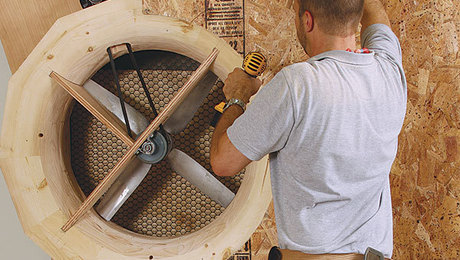STL232: The Mike Mascelli Finishing Show!
Mike Mascelli basically takes over the podcast and answers listeners' questions on finishing and upholstery!Question 1:
From Chip Stoltzfus:
I have been a professional woodworker for almost 25 years. I started out in a large shop making church furniture and have since worked mostly in smaller cabinet shops. In that time every finisher I have worked with has said that you shouldn’t sand with higher than 120 or 150 grit sandpaper. They claimed once you get higher than 150 it polishes the wood and will not let the stain adhere like it was designed. Yet I often hear you talking about sanding to 320 and higher before finishing. All the shops I’ve worked at have used a wiping stain with some type of lacquer topcoat. Is the difference in sanding due to different finishes? I have started using some Rubio Monocoat and I’ve noticed that it gives a smoother finish if the piece is sanded to the higher grits. Thanks for your time and keep up the great work with the podcast.
 |
Question 2:
From David:
I have a problem getting denatured alcohol for my shellac ,I presently use methyl hydrate . Not sure if this is a good product?
 |
Question 3:
From Andrew:
My wife and I just bought a house and there are several rooms that we don’t have furniture for. I’d eventually like to make all of our furniture but I know this will take years. Most of the furniture we’ve picked up in the past has been from antique stores and more in the mid-century style and we both refuse to go to your typical furniture store. I have an idea of what to look for on most furniture to see if it is quality, even if it is a mass produced piece but upholstered furniture is mostly a black hole to me.
I don’t mind spending a bit for something that is of a high quality but considering the amount we’ll likely need I don’t think buying all one off custom pieces is in the cards either.
I know we all often talk about building our own stuff or buying from some of the established big names but sometimes we need to go to the store or order something online so how do we get something that is done the right way in this world of pressed sawdust “furniture”. Thanks.
 |
A Woodworker’s Guide to Upholstery with Michael MascelliUpholstery might seem intimidating at first, but making a comfortable seat cushion is well within the skillset of any woodworker. |
Question 4:
From Lori:
I have an oak coffee table that I applied several coats of polyurethane to. The polyurethane has cured for several months. After I rubbed out the final finish in bright sunlight you can still see a fine scratch pattern. Is that the way the table should look after rubbing out the final coat?
Question 5:
From Greg:
I’d like to be able to use oil-based finishes, but my workshop is in the basement. In the summer months I’ll finish a project outside on the porch or in the garage, but this is not feasible in Michigan in the winter. When I’ve tried using oil-based finishes in the house, even on small projects, the entire house smells. Are there any practical options? Venting?
 |
Question 6:
From Scott:
Once or twice a year we travel to my mother-in-law’s house and when we sit on her wobbly stools or chairs I see that there’s been another failed attempt to glue the joints back together. These stools and chairs have the horizontal supports connected to the legs with a mortise and tenon type joint (a little hole in the leg with the dowel glued in). In the interest of becoming the favorite son-in-law, what is the best way to fix chairs or stools when the joints start failing (and previous attempts to re-glue have failed)?
 |
|
 |
Every two weeks, a team of Fine Woodworking staffers answers questions from readers on Shop Talk Live, Fine Woodworking‘s biweekly podcast. Send your woodworking questions to shoptalk@taunton.com for consideration in the regular broadcast! Our continued existence relies upon listener support. So if you enjoy the show, be sure to leave us a five-star rating and maybe even a nice comment on our iTunes page.





















Comments
I've trying to find alcohol to mix with shellac here in Utah. The only thing I can find in Home Depot and Ace Hardware is labeled fuel alcohol. Neither store could tell me if it can be used with shellac. A paint store told me it could. Haven't used it yet and now I'm not sure if I should. It contains denatured alcohol and methanol. Can anyone help?
Thanks, Bob
As a dedicated reader of FWW and listener to the STL I just finished listening to # 232 and while the topic of finishing was not high on my want to hear list the session was fantastic. As a retired chemist and now a serious hobby woodworker the explanation of the solvents was so good to hear. Mike did a fantastic job hitting the dangers and appropriate uses a good reminder for me and I hope a good education for others.
In addition the excellent description to sanding and toes of wood and finishing was really well done very educational. Thanks for doing this one!
Gregg
So glad to hear from someone who knows finishing. A coat of shellac or a wipe on stain is just a start. Let's hear more about fillers and dyes. The art of the painted finish is a whole anther world. Step up.
Log in or create an account to post a comment.
Sign up Log in